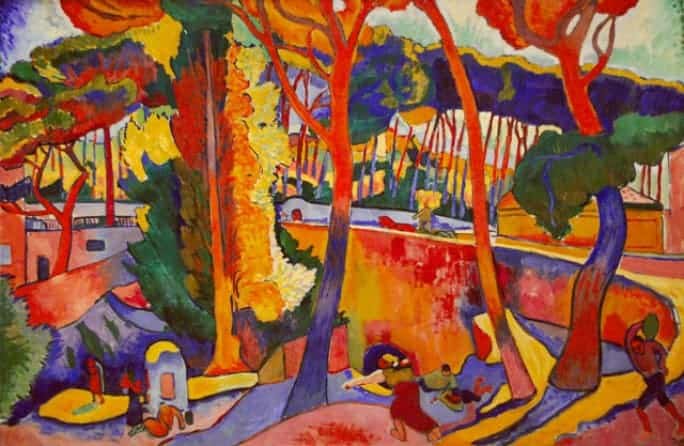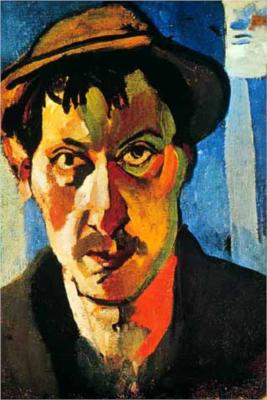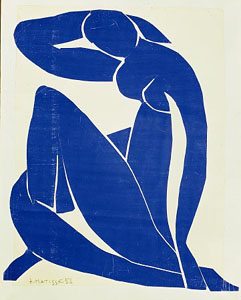1898 – 1920
Fauvism is one f the earliest avant-garde art movements, and greatly influenced German Expressionism, and known for their bold colors and techniques.
These movements centered on the expression of feeling through intense color.

The Fauves worked this through clashing color, distorted forms, alien perspectives, rough brushstrokes, and flat linear patterns on canvases that weren’t always completely covered.
The Expressionists took these ideas and worked in violent colors to show emotional angst, abstracted their forms, and attempted to express modern and contemporary ideas through emotional subject matter.
These two movements – fauvism and expressionism – were some of the first examples of abstract art, only barely predating Cubism, another influential modern art movement.
Fauvism
While Fauvism did start in 1898, it was really only a movement per se between 1904-1908 and had only three exhibitions.

Fauvism has its early roots in the teachings of an inspirational yet controversial professor at the École des Beaux-Arts in Paris, Gustave Moureau.
He was a Symbolist painter (a movement correlating to the gothic and romantic bent of literature at the time) and until his death in 1898 and Henri Matisse’s leadership in 1904, he was considered its philosophical leader.
Many of the Fauvist movement’s artists were his students. He taught originality, expression through color, and to have an open and broad mind. Matisse said, “He disturbed our complacency.”
Matisse was later inspired by a visit to John Peter Russell, an Impressionist painter living on an island off the coast of France.
Henri Matisse – The Beast on the Loose
This was the first time Matisse had seen Impressionist work and the style shocked him. This was in 1896, while Matisse was still a student of Moureau. He left the island because he “could stand” to look at the impressionist works any longer, but returned a year later ready to let go of his own muted palette and learn color theory and the use of the brighter colors preferred by Impressionists.
“The aim of painting is not to reflect history, because this can be found in books. We have a higher conception. Through it, the artist expresses his inner vision.” – Matisse
He claimed to have learned color theory from Russell.
Russell also gave him a gift of a Van Gogh painting, Van Gogh had been a friend of his.
The philosophical direction focus on breaking the boundaries of the mind learned from Moreau and the bold use of color learned from Russell set a foundation in the style of Matisse.
Matisse worked with Andre Derain for the summer of 1905 in a Mediterranean village where they created a body of work to show at the Salon d’Automne
A critic, Louis Vauxcelles, did not appreciate the wild colors of their paintings or the bold and uncongenial execution and declared the artists les Fauves, French for “the wild beasts”. Matisse and Derain were amused and happily adopted the moniker.

Although much of their work was derided at the time and seemed to the general audience to be the work of untalented artists, wealthy collectors like Gertrude Stein brought validity to the movement in the eyes of critics.
Fauvism and Expressionism – Key Differences and Highlights:
- Fauvism was originated in France in the early 20th century, while Expressionism origin simultaneously in Germany and New York
- The Fauves were spontaneous with bright, vivid and colorful strokes, while expressionists used were thoughtful and well planned to ensure that they reflect their inner senses and emotions effectively.
- Fauves enjoyed and promoted collaboration, for which one reason there is a lot of debate around calling it as an art movement.
- Famous fauvism artists were Matisse and Paul Signac. Famous expressionists are Edward Munch and Emily Carr
- Maurice de Vlaminck “loved Van Gogh more than his own father” and after seeing his worked ditched his palette and began squeezing his paint right onto the canvas
- The first true Fauvist painting was completed by Matisse in the summer of 1904. The elements of the painting are the first to coalesce in the Fauvist style.
- The first four members of Die Brücke were architecture students that were interested in art and wanted to create a bridge they would form with the art of the future. The name of the group translates to “The Bridge”.
Top Fauvism Works:
- Woman with a Hat by Henri Matisse
- The River Seine at Chatou by Maurice de Vlaminick
- Le Bonheur de Vivre by Henri Matisse
- Luxe, Calme et Volupte by Henri Matisse
- Blue Nude – Henri Matisse
- Portrait of Henri Matisse – Andre Derain
- La Danse – Henri Matisse
[html_block id=”9712″]
[html_block id=”9474″]

